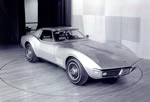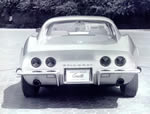Design of the 1968 Corvette: Interview with Larry Shinoda
Design of the 1968 Corvette: Interview with Larry Shinoda
© Wayne Ellwood, Shark Quarterly, 1995
Used here with permission by the author
 |
 |
 |
 |
 |
SHARK: Tell me about the design of the 1968 model?
SHINODA: The design work was started in 1965. There is some good work in "Corvette, America's Sports Car" which has a lot of the photos for the original concept. The nose is quite a bit like the Mako Shark (a little more point) which we did about the same time. The fenders are a little more rounded and the roof shape (wings) are a little more extended. In the production version they were shortened for better vision.
I think that the aspect of the design that might be most interesting to your readers is the fact that most GM designs were the product of competitions. Often there was more than one studio asked to design something around some basic specifications. So what happened was that there had been a design contest between my studio and the Hank Haga studio. Bill Mitchell liked to set up these competitions and take the best ideas for further development.
We had the two (clay models) cars out back on a wide part of the road behind the Tech Centre; this was a very park-like setting and gave a good sense of the natural environment.
Our car was also painted silver using a DI-NOCEP 3M film. We also had rubbed it with some oil to make it look iridescent. Hank Haga thought he would smoke us with a super silver paint job with a blue tint. But the paint shop didn't get a good job and it came out kind of powder blue. And it had a belt line all around it that made it look like a soap dish. Bill Mitchell came out and said, "Damn it, this looks like a fat blue pig". He kicked it and the whole back end fell off. He apologized to Hank for destroying his model but, it didn't really matter because that design lost.
So, after the contest, the car was sent to Haga to finish, because he ran the production studio.
SHARK: When you say that your design was sent to Haga's studio to be finished, it seems like there were a lot of design studios. What were they and why were they arranged like that?
SHINODA: Well, there was Chevy Studio #1 and Studio #2. When my studio was created it was called Studio #3 and I was the first Chief Designer at the Corvette Studio (#3). The second Chief Designer there was Henry Haga, then Jerry Palmer and John Cafaro. I think that Ted Schroeder is now running that studio although John Cafaro is still leading the new 1998 C-5 design team.
There were a number of studios because each tended to specialize in a range of models. Also, Mitchell liked to keep things competitive. In my area, I was kind of "Mitchell's "do it" guy. Whenever there was a competition, my studio would generally win. Henry Haga did win with some of his ideas though; we all had our days.
Mitchell was a bit funny too. He would come in with some weird ideas which we had to get him to change. He always wanted more gadgets on the cars, like the pop-up brake panels on the MAKO SHARK II. You could generally get him to change his mind if you made him think he had come up with the alternative; but sometimes he would just keep asking for more and more (gimmicks) design features.
Some of the stuff was very pretty. Like on Mako Shark I, for example. At one point we had some very delicate louvres radiating on the side of the hood bulge to help cool a Latham supercharger which was on the engine. You could look through and actually see the supercharger.
There were some other ideas that didn't work out too. Like the Stingray Racer which he wanted painted metallic red. In my opinion, it came out a tomato soup. That was on the first body which was the original lay-up. It was really thick to get a good surface; it must have been 5/16 of an inch thick and really heavy. Well then we put on the first vacuum bagged body and it was painted silver. This body was a lot lighter and the car was starting to get into a competitive weight range. A little while later, they wanted the car for an Elvis Presley movie so we put the old body back on and painted it a candy apple red. There was a clear plastic bubble on the hood so you could see the Webers but the carbs were always coughing and backing-up causing the plastic to fog anyway. After that we put the original body back on and painted it silver again; we put in a ZL-1 engine but that's not there anymore either.
SHARK: Were you involved with some of the design for the interior of Mako Shark II. The SHARK era dash, for example, is considered to be a real landmark in sportscar design.
SHINODA: I didn't get involved in the interior design. That was George Angersbbach. John Schetler,and Sue Vanderbilt who worked on that part. There were more people in the interior design studio but I have forgotten a lot of them. But they did a lot of good work.
You will notice from a lot of the photos that there were two versions of Mako Shark II. The one with the side pipes was a non-running model. The running model didn't have that feature. I was the Chief designer and the Chief Coordinator for the build of both cars. The dash was done by a different working group which I coordinated but I didn't have any final say on that. Mitchell had the final say.